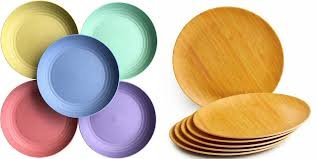1. Introduction: The Rise of Eco-Friendly Tableware
As the world continues to move away from plastic pollution and single-use waste, eco-friendly disposable tableware has become a global trend. Consumers and businesses alike are turning to sustainable materials like bamboo, wood, and wheat straw to reduce their environmental footprint.
Among the leading innovators in this field is anzhucraft.com — a Chinese company specializing in eco-friendly disposable tableware that combines natural aesthetics, practicality, and sustainability. This article explores the differences between wheat straw and bamboo plates, helping you make an informed and environmentally conscious choice.
2. Understanding the Materials
2.1 What is Wheat Straw?
Wheat straw is the residual stalk left after harvesting wheat grains. In the past, farmers often burned it, causing pollution. Today, this byproduct is repurposed to create biodegradable and compostable products such as plates, cups, and cutlery.
2.1.1 How It’s Made
The process involves grinding wheat straw fibers and mixing them with natural binders. This mixture is then molded into plates and utensils, resulting in a sturdy yet lightweight product suitable for single or repeated use.
2.1.2 Key Properties
- Lightweight and durable
- Microwave and freezer safe
- Fully biodegradable within months
- Non-toxic and BPA-free
2.2 What is Bamboo?
Bamboo, known for its rapid growth and renewability, is a natural grass that has long been used in Asian craftsmanship. Its strength, sustainability, and elegant texture make it ideal for eco-friendly tableware production.
2.2.1 How It’s Made
Bamboo culms are harvested, cleaned, and pressed into sheets or molded into shapes using heat and pressure. The result is a durable, smooth, and reusable plate with natural antibacterial properties.
2.2.2 Key Properties
- Strong and reusable
- Naturally antibacterial and odor-resistant
- 100% biodegradable and compostable
- Elegant and smooth texture
3. Environmental Impact Comparison
3.1 Sustainability and Renewability
Both wheat straw and bamboo are renewable resources. However, their growth cycles differ.
- Wheat straw is a byproduct of an already existing crop, meaning no additional land or water is required for its production.
- Bamboo, on the other hand, grows rapidly and can regenerate without replanting, making it a long-term sustainable material.
Verdict: Wheat straw wins in resource efficiency, while bamboo excels in long-term renewability.
3.2 Carbon Footprint
- Wheat straw plates require less energy to produce since the raw material is lightweight and easily processed.
- Bamboo plates, being denser and requiring more preparation, have a slightly higher energy consumption during production.
Verdict: Wheat straw has a lower carbon footprint in the short term.
3.3 Biodegradability and Disposal
Both materials decompose naturally within 4 to 6 months under composting conditions.
- Wheat straw breaks down slightly faster because it’s less dense.
- Bamboo may take longer but leaves no harmful residue.
Verdict: Both are eco-friendly, but wheat straw decomposes faster.
4. Functional Comparison: Strength and Performance
4.1 Durability and Heat Resistance
- Bamboo plates are notably stronger and more durable, ideal for both hot and cold dishes.
- Wheat straw plates, though sturdy, are designed mainly for light meals and moderate temperatures.
Verdict: Bamboo is superior in strength and heat resistance.
4.2 Weight and Convenience
- Wheat straw plates are lightweight and easy to carry, making them perfect for outdoor events and parties.
- Bamboo plates are heavier and more rigid, providing a premium dining experience.
Verdict: Wheat straw offers better portability; bamboo offers elegance and structure.
4.3 Reusability
While wheat straw plates are primarily disposable, they can sometimes be reused a few times with proper care.
Bamboo plates, however, are designed for multiple uses, maintaining their structure and finish over time.
Verdict: Bamboo offers higher reusability.
5. Health and Safety Benefits
5.1 Chemical-Free Production
Both wheat straw and bamboo products from AnzhuCraft are manufactured without harmful chemicals, ensuring that no toxins leach into food.
5.2 Antibacterial Properties
Bamboo naturally resists bacterial growth, while wheat straw’s smooth surface helps maintain cleanliness during use.
5.3 Food-Grade Certification
AnzhuCraft ensures all its products meet international food-grade standards, making them safe for both children and adults.
6. Aesthetic and Design Appeal
6.1 Natural Look
Both materials feature a minimalist, earthy appearance that complements eco-conscious lifestyles.
- Wheat straw plates have a soft beige hue.
- Bamboo plates showcase a smooth, wood-like grain that looks sophisticated.
6.2 Customization at AnzhuCraft
AnzhuCraft offers custom designs, branding, and packaging for both bamboo and wheat straw plates — making them ideal for restaurants, catering services, and eco-friendly brands worldwide.
7. Cost Considerations
7.1 Production and Pricing
- Wheat straw plates are typically more affordable because they use agricultural byproducts.
- Bamboo plates, being crafted from solid material, are priced higher but offer greater longevity.
7.2 Value for Money
For one-time events, wheat straw plates provide excellent value. For businesses seeking reusability and premium appeal, bamboo plates are the better investment.
8. Choosing the Right Plate for You
8.1 When to Choose Wheat Straw
- For picnics, parties, or large events
- When cost efficiency and biodegradability are top priorities
- If you prefer lightweight, compostable disposables
8.2 When to Choose Bamboo
- For restaurants, cafes, or eco-friendly businesses
- When durability and visual appeal matter most
- If you aim for a reusable, long-term sustainable option
9. Why Choose AnzhuCraft
9.1 Commitment to Sustainability
At AnzhuCraft, every product is designed with the planet in mind. Their tableware reflects a balance of functionality, beauty, and environmental responsibility.
9.2 Quality and Innovation
With advanced manufacturing techniques, AnzhuCraft ensures that both bamboo and wheat straw plates meet the highest international quality standards, delivering durable and elegant eco-friendly alternatives to plastic.
9.3 Global Reach
From catering companies to eco-conscious consumers, AnzhuCraft serves customers around the world who value sustainability without compromise.
10. Conclusion: A Greener Choice for a Better Future
Both wheat straw and bamboo plates represent the future of sustainable dining — and AnzhuCraft stands at the forefront of this green revolution. Whether you prioritize affordability, biodegradability, or reusability, there’s an eco-friendly option for every need.

